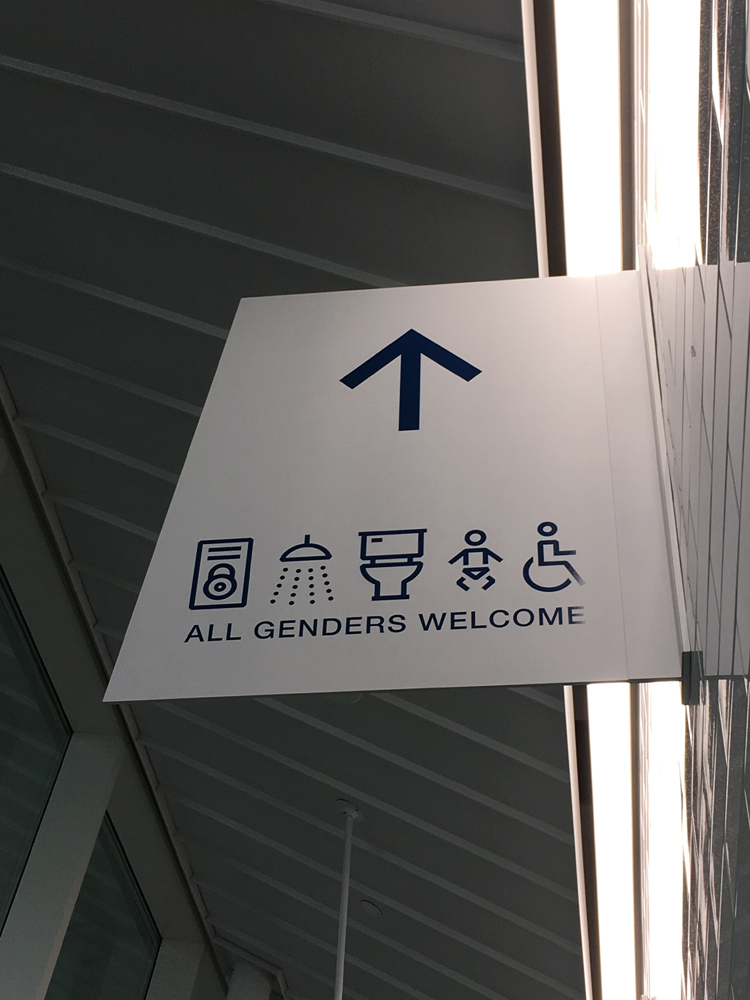Gender Diversity in a Changing Climate
Text by Ali Greey and Phaedra Maicantis
It is no surprise to the profession of landscape architecture that design decisions are not neutral, but impact who can access public space, and who is excluded. How can the design of public facilities such as parks, public pools, beaches changing rooms, etc., reflect the responsibility to create safe, inclusive, and accessible public spaces for people of all genders?
The design and access of public spaces, such as parks and their facilities, including public bathrooms and locker rooms, has a direct impact on transgender and gender non-binary (trans) people and their participation in the public realm. From the way open public space and parks are delineated, to the existence and quality of their facilities, design attributes can often inadvertently contribute to gendering practices that exclude, rather than include.
For trans people, spaces like binary-gendered (men’s/women’s) locker rooms and restrooms are frequently spaces of harassment, social alienation, and physical violence. It’s no wonder, then, that many trans people report avoiding these facilities whenever possible. The imperative to avoid these spaces, however, has a negative impact on trans people’s ability to participate in the public sphere. Access to public restrooms, for instance, is necessary for sustained participation in public space. There are biological imperatives no one can avoid. Not surprisingly, empirical evidence suggests that disproportionate numbers of trans people report trying to “hold it” because of the physical violence and social alienation they experience in public restrooms. These attempts to avoid using binary-gendered facilities not only give rise to chronic adverse health impacts, but also reduced involvement in the public sphere.

As far as public locker rooms go, being nude in the company of strangers is an experience that many of us would rather avoid. But for trans people, these spaces, often necessary for physical activity, marked “men’s” and “women’s,” can often be a barrier.
Binary-gendered facilities implicitly perpetuate widespread assumptions about sex and gender, as a category with only two discrete options. Scientific evidence, like the work of biology professor Dr. Anne Fausto-Sterling, suggests not only that gender is a socially fluid category, but also that biological sex exists on a continuum consisting of myriad sexes, not only two. Binary-gendered facilities, which require users to sort themselves into one of two gendered categories, quietly reinforce ideas that binary gender is natural and the only way to be normal.
What stands before landscape architects, those responsible for designing our public spaces, is an architectural puzzle. Abolishing binary gender spaces might advance inclusivity for some, but it could also operate to exclude others. Ali’s research suggests that trans people might not necessarily find universal facilities more accessible spaces than binary-gendered facilities, they may simply face different types of barriers. Offering a third space, however, as an alternative to men’s and women’s facilities, can help make public space and physical activity more accessible to trans people.
Landscape architecture can play an influential and relevant role in shaping and designing spaces to create greater inclusion with the intent of examining and challenging binary design assumptions about how spaces are perceived and navigated according to gender. The presence of trans people in the planning process would certainly increase accessibility and safety if their needs, values, and preferences are considered in the design, development, and implementation. However, trans people need not be present to make these design decisions. Landscape architects of all genders can choose to anticipate the presence of trans people in the spaces they design, making design decisions that welcome all people, irrespective of gender, to participate.
BIOS/ Ali Greey is a trans doctoral student in sociology at the University of Toronto. Their published work has appeared in peer-reviewed academic journals such as Leisure Studies, and their work has been included in edited volumes such as The Routledge Handbook of Athlete Welfare. Ali is also a retired Canadian national team boxer.
Phaedra Maicantis has a Master of Landscape Architecture from the University of Guelph, with research that focused on gender, access and public spaces.
